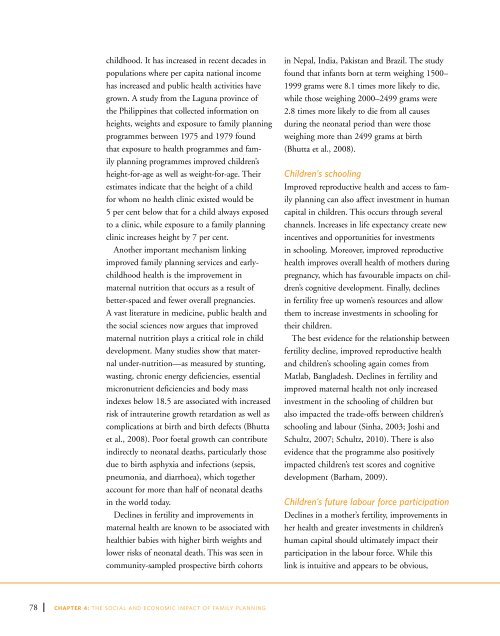State of World Population 2012 - Country Page List - UNFPA
State of World Population 2012 - Country Page List - UNFPA
State of World Population 2012 - Country Page List - UNFPA
You also want an ePaper? Increase the reach of your titles
YUMPU automatically turns print PDFs into web optimized ePapers that Google loves.
childhood. It has increased in recent decades in<br />
populations where per capita national income<br />
has increased and public health activities have<br />
grown. A study from the Laguna province <strong>of</strong><br />
the Philippines that collected information on<br />
heights, weights and exposure to family planning<br />
programmes between 1975 and 1979 found<br />
that exposure to health programmes and family<br />
planning programmes improved children’s<br />
height-for-age as well as weight-for-age. Their<br />
estimates indicate that the height <strong>of</strong> a child<br />
for whom no health clinic existed would be<br />
5 per cent below that for a child always exposed<br />
to a clinic, while exposure to a family planning<br />
clinic increases height by 7 per cent.<br />
Another important mechanism linking<br />
improved family planning services and earlychildhood<br />
health is the improvement in<br />
maternal nutrition that occurs as a result <strong>of</strong><br />
better-spaced and fewer overall pregnancies.<br />
A vast literature in medicine, public health and<br />
the social sciences now argues that improved<br />
maternal nutrition plays a critical role in child<br />
development. Many studies show that maternal<br />
under-nutrition—as measured by stunting,<br />
wasting, chronic energy deficiencies, essential<br />
micronutrient deficiencies and body mass<br />
indexes below 18.5 are associated with increased<br />
risk <strong>of</strong> intrauterine growth retardation as well as<br />
complications at birth and birth defects (Bhutta<br />
et al., 2008). Poor foetal growth can contribute<br />
indirectly to neonatal deaths, particularly those<br />
due to birth asphyxia and infections (sepsis,<br />
pneumonia, and diarrhoea), which together<br />
account for more than half <strong>of</strong> neonatal deaths<br />
in the world today.<br />
Declines in fertility and improvements in<br />
maternal health are known to be associated with<br />
healthier babies with higher birth weights and<br />
lower risks <strong>of</strong> neonatal death. This was seen in<br />
community-sampled prospective birth cohorts<br />
in Nepal, India, Pakistan and Brazil. The study<br />
found that infants born at term weighing 1500–<br />
1999 grams were 8.1 times more likely to die,<br />
while those weighing 2000–2499 grams were<br />
2.8 times more likely to die from all causes<br />
during the neonatal period than were those<br />
weighing more than 2499 grams at birth<br />
(Bhutta et al., 2008).<br />
Children’s schooling<br />
Improved reproductive health and access to family<br />
planning can also affect investment in human<br />
capital in children. This occurs through several<br />
channels. Increases in life expectancy create new<br />
incentives and opportunities for investments<br />
in schooling. Moreover, improved reproductive<br />
health improves overall health <strong>of</strong> mothers during<br />
pregnancy, which has favourable impacts on children’s<br />
cognitive development. Finally, declines<br />
in fertility free up women’s resources and allow<br />
them to increase investments in schooling for<br />
their children.<br />
The best evidence for the relationship between<br />
fertility decline, improved reproductive health<br />
and children’s schooling again comes from<br />
Matlab, Bangladesh. Declines in fertility and<br />
improved maternal health not only increased<br />
investment in the schooling <strong>of</strong> children but<br />
also impacted the trade-<strong>of</strong>fs between children’s<br />
schooling and labour (Sinha, 2003; Joshi and<br />
Schultz, 2007; Schultz, 2010). There is also<br />
evidence that the programme also positively<br />
impacted children’s test scores and cognitive<br />
development (Barham, 2009).<br />
Children’s future labour force participation<br />
Declines in a mother’s fertility, improvements in<br />
her health and greater investments in children’s<br />
human capital should ultimately impact their<br />
participation in the labour force. While this<br />
link is intuitive and appears to be obvious,<br />
78 CHAPTER 4: THE SOCIAL AND ECONOMIC IMPACT OF FAMILY PLANNING
















